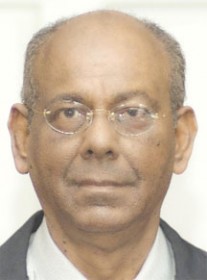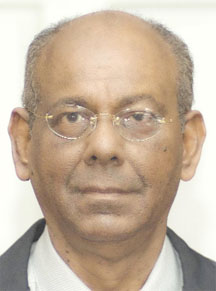If the leadership of the ruling PPP fails to unanimously agree on a presidential candidate, nominations will likely take place and a secret ballot will be taken, according to executive member Ralph Ramkarran.

“I, and I believe everyone else in the leadership of the PPP, expect that unless a candidate is unanimously agreed upon and accepted by the Central Committee, at the appropriate time nominations will take place and a secret ballot will be taken,” Ramkarran wrote in a letter, published in Stabroek News on October 1. He added that nominations can potentially include any member of the leadership, whether that person has declared an interest or not. “I am not talking about any special rules which exist but about normal democratic practices in any democratically managed organisation such as the PPP. This, I believe is in accordance with the decision announced by the party about the method of selection. It is the voting members who will decide by their vote whether to support one of the announced candidates, if nominated, or some other person, also if nominated,” he explained.
Stabroek News sought to contact PPP General Secretary Donald Ramotar to confirm that a secret ballot would be used to vote on nominees, in the event that the party fails to reach consensus at the level of either the Executive Committee or the Central Committee. However, several attempts were unsuccessful.
The PPP has said its current selection process has been used to identify all its presidential candidates; late former presidents Dr Cheddi Jagan and Mrs Janet Jagan as well as current President Bharrat Jagdeo. According to the party, the procedure allows for the nomination/expression of interest by interested individuals, deliberations at the level of the Executive Committee, and subsequent approval by the Central Committee. The approved candidate will then be announced to the membership through regional conferences, the party further noted.
The PPP’s decision to retain the method for the selection of the candidate shut the door on the push by MP Moses Nagamootoo for a broader approach.
In his letter, Ramkarran said the PPP has not yet reached the stage of open campaigns for leadership positions and presidential candidates. “I am sure it will get there soon,” he, however, added. “Such a method of choosing will do no harm to the party and will strengthen its internal democracy.” According to him, the current method is based on a specific history, during which the party had to prepare itself for the possibility of operating underground if it were made illegal and of securing and maintaining maximum unity. Such methods cannot last in current conditions, he said.
Unlike the last two general elections, there is no automatic presidential candidate for the PPP, owing to the ineligibility of President Jagdeo to seek re-election because of a constitutional term-limit. In addition to Ramkarran, Ramotar and Nagamootoo, Home Affairs Minister Clement Rohee has also publicly declared his interest in serving as the party’s candidate. Agriculture Minister Robert Persaud has also been mentioned as a possible choice.
Ramkarran’s letter was prompted by the assertion in a Kaieteur News editorial that Janet Jagan had been proposed as a compromise candidate in 1997 to break a deadlock at the Executive Committee between him and Nagamootoo as the choice for candidate then. The editorial, entitled ‘PPP Presidential Candidate,’ stated: “In the run-up to the 1997 elections, with the passing of Dr Jagan, it was reliably reported that there was a deadlock in the Ex-Co between two candidates (Messrs Ramkarran and Nagamootoo). Mrs Jagan was proposed as a compromise candidate, and the rest, as they say, is history.”
Ramkarran denied the account. He said that at the Executive Committee meeting in August 1997, at which the issue of the candidacy was first discussed, Nagamootoo’s candidacy was ruled out since he had indicated that he was not available as a candidate. He said Nagamootoo’s position was noted at the meeting. “There was therefore no deadlock between myself and Moses, and Mrs Jagan was not proposed as a compromise candidate,” he said.
According to Ramkarran, at the meeting there was a broad, wide-ranging discussion on the issue and many comrades were proposed and considered for recommendation to the Central Committee, including himself and Mrs Jagan. Several who were named, he added, also indicated that they did not wish to be considered. “At the end of the discussions, it was agreed that Mrs Jagan would be recommended to the Central Committee as the candidate. This decision was based on the fact, among other things, that Mrs Jagan was the person most likely to ensure victory at the elections. The decision had nothing to do with any compromise,” he said.
He further added that “the theory that those persons in the PPP who have indicated a willingness to offer themselves as nominees for the candidacy are in such a deadly struggle with each other that a compromise candidate will have to be introduced or would be necessary to break some imaginary deadlock is a fanciful contrivance and is not grounded in reality.”
However, Ramkarran’s account has received an addendum by Lionel Peters, who, in a letter published in the October 2 edition of this newspaper, said while there were several candidates, including Roger Luncheon, it came down to a straight fight between Nagamootoo and Ramkarran, with the latter winning out in the end.
According to Peters, who cites several senior functionaries in both party and government as his sources, at this point the Executive Committee called on Ramkarran to satisfy two conditions, being, a full commitment and full disclosure of his financial records. Peters said he refused on both counts, resulting in fellow Executive Committee members questioning their choice. “At this juncture in stepped [Janet Jagan], announcing (she always had the door ajar on the discussions) that since they couldn’t agree on a candidate and elections were around the corner, she was taking the position. She then said that she had spoken to Sam Hinds and he had agreed to run as her prime ministerial candidate,” he wrote. He added that Mrs Jagan subsequently noted that the composition of the slate did not cater for the core support base of the PPP, arguing that it needed to be reflected in the top three on the slate to be presented to the Central Committee. “Those of us in the PPP who had studied the party’s constitution also knew that there was absolutely no commitment to the Civic on a continuation of them holding the prime ministerial position.
At this juncture the executive members decided, unsuspectingly, to nominate a non-contender for power, Bharrat Jagdeo, as the third candidate. They all felt that this was a Janet thing and they would have time to emerge later. This is how Bharrat Jagdeo’s name entered the equation, and as we say, the rest is now history.”

